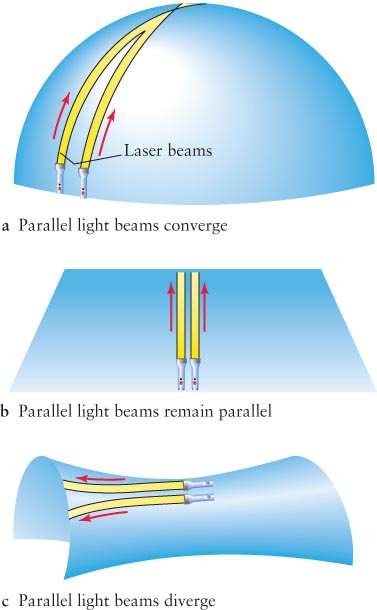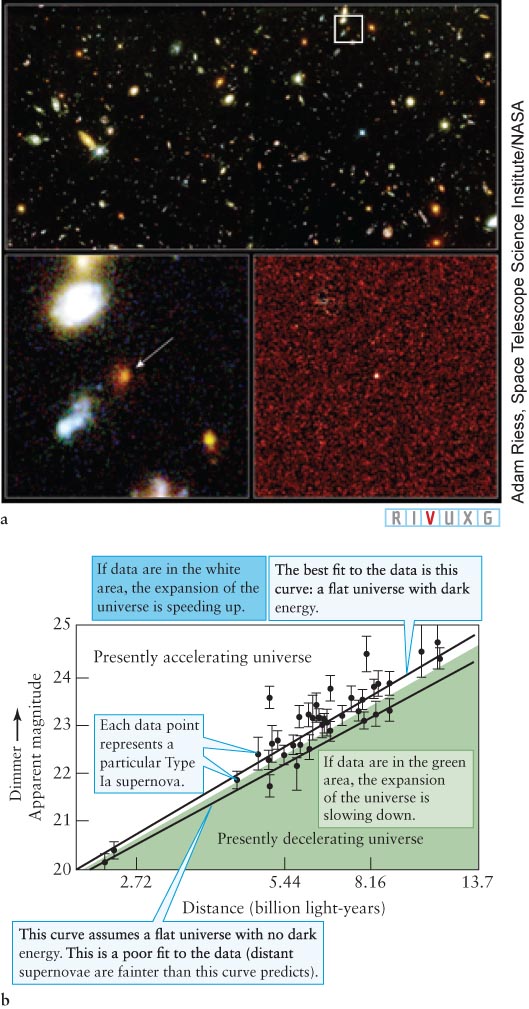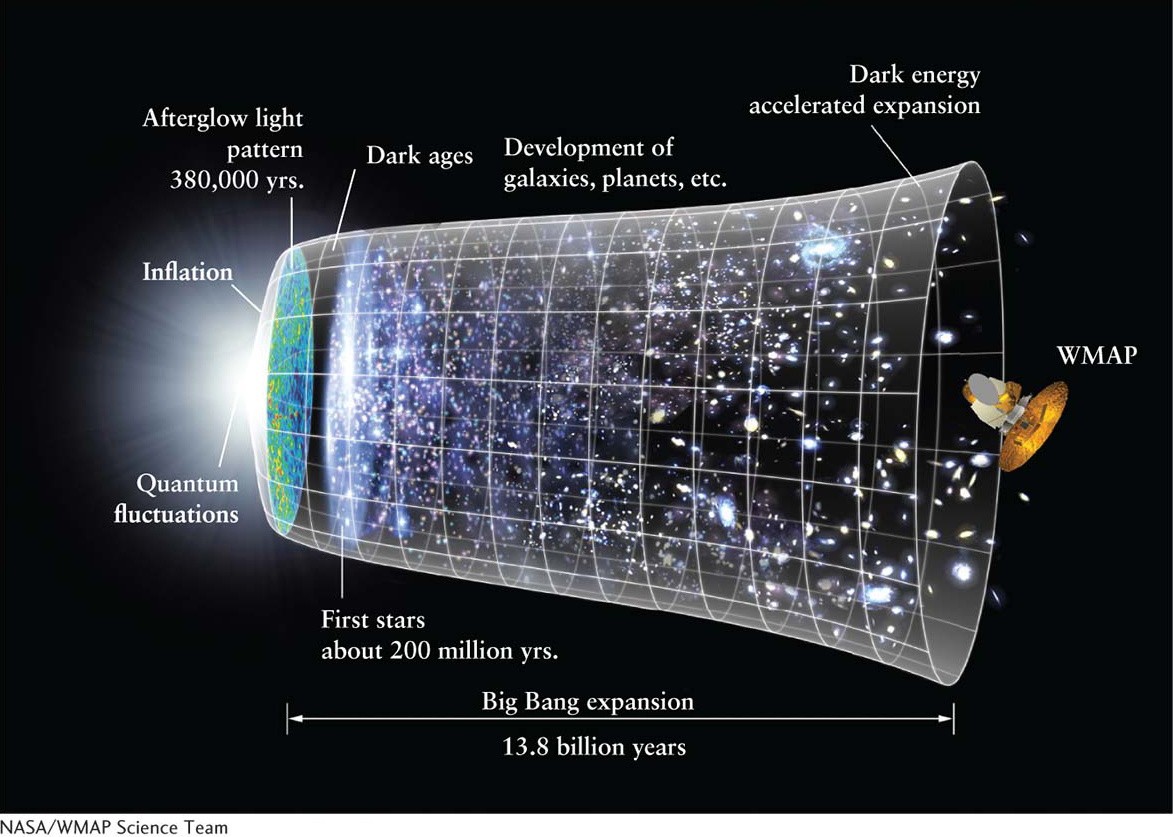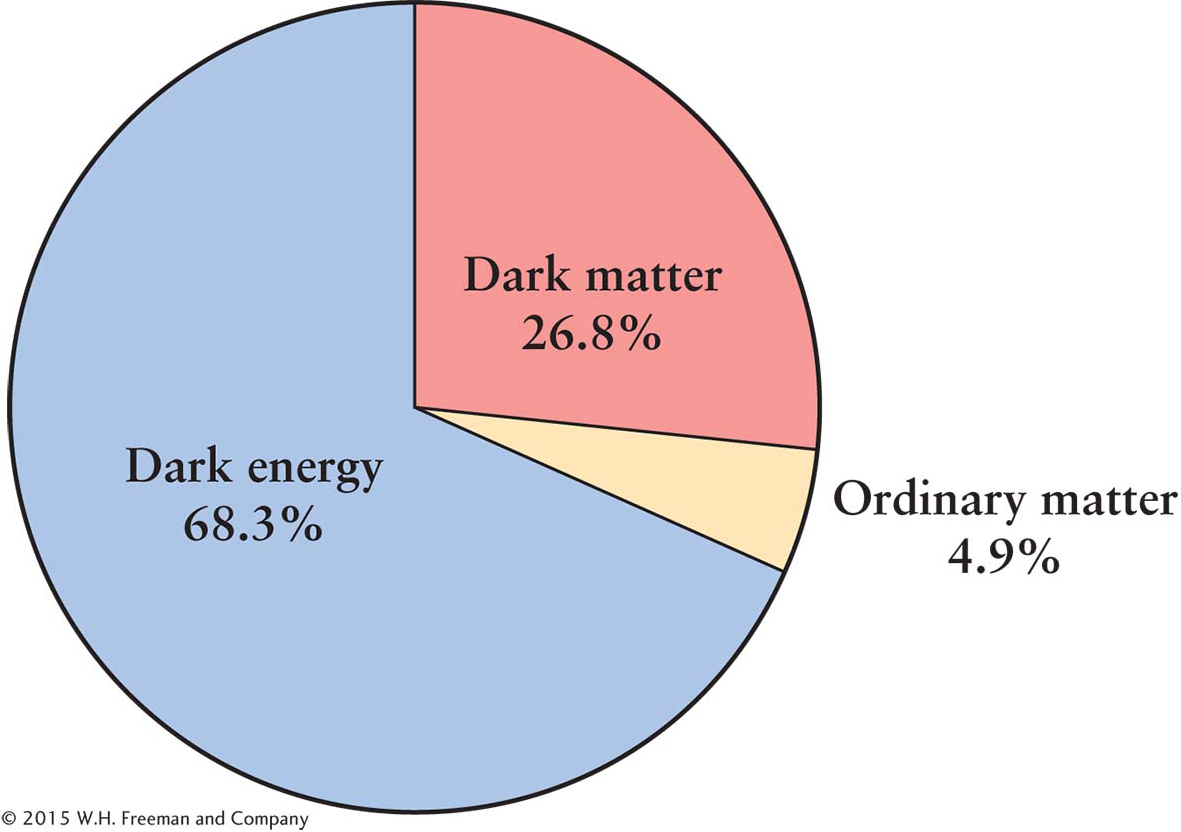THE FATE OF THE UNIVERSE
We now turn to the future. Will the universe last forever? Or will it someday stop expanding and collapse?
14-13 The average density of matter is one factor that determines the future of the universe
As superclusters move apart in the expanding universe, their mutual gravitational attractions act on one another and thereby slow the rate at which they separate. If that were all that mattered in determining the fate of the universe, you could simply locate and add up all of the visible and (presently) dark matter in existence and see if the mutual gravitational force acting between all the components is enough to eventually stop the expansion.
This process is analogous to what engineers do in calculating, for example, how high a cannonball shot upward from the surface of Earth will travel. Earth’s gravitational force slows the ball’s ascent. If the cannonball’s speed upward is less than the escape velocity from Earth’s gravity (about 11 km/s or 7 mi/s straight up), it will fall back to Earth. If the ball’s speed exceeds the escape velocity, it will leave Earth and continue outward forever, despite the relentless pull of Earth’s gravity. On the boundary between these two scenarios is the situation when the cannonball’s speed equals the escape velocity. In that case, the cannonball will just barely escape falling back to Earth, slowing forever, and come to rest an infinite distance away at an infinite time in the future.
461
By analogy with the cannonball fired from Earth, it would seem that if the universe is expanding too slowly to overcome the mutual gravitational attraction of its parts, it should stop expanding and someday collapse. If it is expanding at exactly its escape velocity, it should expand until coming to a stop an infinite time in the future. Or if it is expanding fast enough, it should slow down but continue to expand forever. However, none of these options is correct!
The laws of physics pertaining to the evolution of the universe, as spelled out in the theory of general relativity and in recent observations of distant objects, reveal that reality is more complex than this simple analogy. Just when astronomers were getting comfortable with the idea that the gravitational force is always attractive, general relativity once again showed that reality ignores our common sense by demonstrating that either gravity has a repulsive component or, equivalently, that there is a fifth force in nature that is repulsive on very large scales.
To understand the fate of the universe, we must consider two large-
14-14 The overall shape of spacetime affects the future of the universe
During the 1920s, Alexandre Friedmann in Russia, Georges Lemaître in Belgium, Willem de Sitter in the Netherlands, and Einstein himself applied the theory of general relativity to the expanding universe. General relativity predicts that the presence of matter curves the fabric of spacetime, as we saw in Chapters 12 and 13, in the form of gravitational lensing and the distortion of spacetime around black holes. Similarly, the presence of energy also curves spacetime—
Focus Question 14-12
What, if any, objects have we given enough velocity to escape forever from Earth?
Only three possibilities exist for the overall shape of the universe. These possibilities are determined by the amount of mass and energy the universe contains and how fast it is expanding. For example, imagine shining two powerful laser beams out into space. Suppose that we can align these two beams so that they are perfectly parallel as they leave Earth. Suppose, further, that nothing gets in the way of these two beams. We follow them across the spacetime whose shape we wish to determine. The light beams will begin to diverge due to the expanding universe carrying them apart. This effect happens regardless of any properties of the spacetime, and, because we are not interested in the effect of expansion right now, we compensate for it (that is, we ignore it) in what follows. The three possibilities for the paths of the laser beams, due to the actual curvature of the universe, are the following:
Two beams of light, starting out as parallel, gradually get closer and closer together as they move across the universe, eventually intersecting at some enormous distance from Earth (Figure 14-20a). In this case, we say that space is positively curved. Analogously, the lines of constant longitude on Earth’s surface are parallel at the equator but intersect at the poles. Thus, if the universe has this effect on light, the shape of the universe is like the surface of a sphere: Space is spherical and the universe has positive curvature. This shape would happen if the universe had such high mass and energy densities that the mass and energy literally curved space back in on itself. In the absence of any outward-
pushing force, such as would be supplied by a sufficiently large cosmological constant (see Section 14- 1 ), such a universe does not have enough energy to keep expanding forever. It would someday stop expanding and thereafter collapse. Figure 14-20 Possible Geometries of the Universe The shape of space (represented here as two-
Figure 14-20 Possible Geometries of the Universe The shape of space (represented here as two-dimensional for ease of visualization) is determined by the matter and energy contained in the universe. The curvature is (a) positive, (b) zero, or (c) negative, depending on whether the average matter and energy density throughout space is greater than, equal to, or less than a critical value. The lines on each curve are initially parallel. They converge, remain parallel, or diverge, depending on the curvature of space. 462
It is easiest to understand such a universe by visualizing a two-
dimensional version of it as being the surface of a balloon on which you must remain. In such a universe, you could, in principle, keep going in a straight line (which is a curve on the balloon’s surface) and eventually end up back where you started. Like the surface of a balloon, a three- dimensional universe with positive curvature has no outside or center and is said to be a closed universe. Two initially parallel beams of light remain parallel regardless of how far they travel (Figure 14-
20b). In this case, space is not curved. That is, space is flat and it can extend without limit. This is the structure that meets our commonsense belief. Two initially parallel beams of light gradually diverge farther and farther apart as they move across the universe (Figure 14-
20c). This is what would happen if the energy of the Big Bang was sufficiently great to ensure that the universe is going to expand forever. In this case, the universe has negative curvature. A horse’s saddle is a good example of a negatively curved or hyperbolic surface. Initially parallel lines drawn on a saddle always diverge. Thus, in a negatively curved universe, we would describe space as hyperbolic. A hyperbolic universe extends without limit and is called an open universe. Both the flat and the hyperbolic universes are open and will grow larger forever.
Most astronomers have come to believe that the universe is flat. The reason for this stems from the observations that the universe is homogeneous and isotropic. The only mechanism we have at present to explain these properties of the matter and energy distribution in space is inflation, as discussed earlier. However, the equations predict that if inflation occurred, it stretched the volume of the universe and the matter and energy in it so much that the universe must be very nearly flat.
Telescopic observations strongly support the belief that the universe is flat. This conclusion comes from examining the sizes of the regions of slightly higher and lower temperature in the cosmic microwave background (see Figure 14-

463
14-15 Dark energy is causing the universe to accelerate outward

Until the past few years, there was a major inconsistency between the distribution of observed matter and energy in the universe and the flatness of space. Just as there is not enough visible matter to account for galaxies and clusters of galaxies that remain as bound systems, there is not enough observed matter and energy to account for a flat universe. Visible matter accounts for only 5% of the required mass. The cosmic microwave background photons add only 0.005% of the required gravitational effects needed for flatness, and calculations of the mass necessary to keep galaxies and clusters bound, combined with gravitational lensing by dark matter of distant galaxies and quasars, reveal that the dark matter known to exist accounts for only about 27% of the required mass. Therefore, the universe has only about 32% of the required mass and energy necessary to make it flat. Allowing for the errors that still exist in all of these observations, the possible range of mass and energy from all matter and photons in the universe is still between only 25% and 30% of that required for flatness. Yet flat it certainly appears to be.
By the mid-
Corroborating evidence for the existence of such dark energy was found in the recent observations of Type Ia supernovae in extremely distant galaxies (Figure 14-22). The light curves (see Section 12-

464
There must be some kind of repulsive force acting to increase the rate at which superclusters separate today. Astronomers hypothesize that this is due to some kind of dark energy that has a repulsive gravitational effect, as mentioned earlier. Confirmation that dark energy exists came in 2003, when astronomers observed light from very distant galaxies passing through clusters of galaxies closer to us on its way toward Earth. As the distant light moved toward a cluster on its way to us, that light was gravitationally blueshifted, meaning the light gained energy as it was pulled toward the cluster. If there were no dark energy in a flat universe, then, as that light left the vicinity of the cluster, it would have been redshifted (lost energy) by exactly the same amount and come to us with the same wavelengths it would have had if it had never passed through the cluster.
However, if dark energy exists, then the universe is accelerating outward (expanding outward faster and faster). So the universe would have expanded more during the time that the light was leaving the cluster than when that light was first moving toward the cluster. The universe’s acceleration helps carry the departing photon away from the cluster, so the photon does not have to use as much energy leaving the cluster as it gained traveling toward it. Under those conditions, the light would have gained more energy from the cluster’s gravitational attraction while traveling toward the cluster than the light would have lost to that gravitational attraction as it was moving away from the cluster. In other words, the amount of blueshift that the light underwent falling into the cluster would be greater than the amount of redshift that it underwent leaving the vicinity of the cluster. This was precisely what astronomers discovered: The light from distant galaxies undergoes a net blueshift when it passes through clusters of galaxies on its way to us—
Cosmological constantThere are presently two viable theoretical explanations for dark energy. Let us first consider what would happen if the cosmological constant that Einstein introduced and then rejected actually did exist. As Einstein had intended, it would provide a repulsive force to nature. The energy associated with that force would appear in the vacuum of space. The cosmological constant form of vacuum energy has the property of contributing a constant repulsive gravitational force that competes with the normal attractive gravitational force from matter and radiation that slows down the expansion. Which gravitational force wins depends on whether there is more vacuum energy or more matter and radiation.
As the universe expands, the average density of matter and energy decreases. In other words, on average there is less matter and energy in each cubic meter or yard of space every second than there was the second before. However, the density of energy created by the cosmological constant is unchanged—
465
The concern that some astronomers express about the cosmological constant is that the repulsive force it creates has just the right strength to have allowed the universe to slow down for several billion years and then to slowly cause it to accelerate outward, as seen today. To explain this apparent coincidence would require fine-
QuintessenceDespite these concerns, observations of distant Type Ia supernovae suggest that the outward force acting on the universe is nearly constant, consistent with the dark energy being created by the physics we characterized with the cosmological constant. However, these observations do not yet rule out the major competing theory of dark energy, called quintessence. Scientists are exploring a variety of mathematical descriptions of quintessence. Quintessence differs from the vacuum energy associated with the cosmological constant in that the energy of quintessence is not constant but changes slowly with the expansion of the universe and can also be changed by the flow of energy and matter through the universe. Because it can change, quintessence need not have been fine-
As the universe grew, the energy in quintessence would eventually come to dominate the gravitational energy from matter. If this took place a few billion years ago, quintessence would have begun exerting a negative gravitational force and so the universe would have begun accelerating.

 The unexpected discovery that the universe is accelerating outward completely alters astronomers’ perspectives about the fate of the cosmos. This discovery tells us that the universe will expand forever. At the same time, it neatly solves the mystery of why the universe is flat, as required by the occurrence of inflation in the early universe. Dark energy provides the remaining 68% of the energy needed to account for the universe being flat. The contributions of all of its major components to the mass and energy in the universe are shown in Figure 14-24, with details listed in Appendix L: Mass and Energy Inventory for the Universe.
The unexpected discovery that the universe is accelerating outward completely alters astronomers’ perspectives about the fate of the cosmos. This discovery tells us that the universe will expand forever. At the same time, it neatly solves the mystery of why the universe is flat, as required by the occurrence of inflation in the early universe. Dark energy provides the remaining 68% of the energy needed to account for the universe being flat. The contributions of all of its major components to the mass and energy in the universe are shown in Figure 14-24, with details listed in Appendix L: Mass and Energy Inventory for the Universe.
We have seen that our present understanding of the laws of nature is incomplete, especially in that our theories do not explain the nature of the universe during the Planck era (or why the universe began in the first place). Driven by these challenges, scientists have begun to develop superstring theories that may resolve these issues. Discovery 14-1: Superstring Theory and M-Theory is intended to give you a brief introduction to them and what they now predict.
 Cosmic Microwave Background and the Curvature of Space Temperature variations in the early universe appear as “hot spots” in the cosmic microwave background. The apparent sizes of these spots depend on the curvature of space. (a) In a closed universe with positive curvature, light rays from opposite sides of a hot spot bend toward each other. Hence, the hot spot appears larger than it actually is (dashed lines). (b) The light rays do not bend in a flat universe. (c) In an open universe, light rays bend apart. The dashed lines show that a hot spot would appear smaller than its actual size.
Cosmic Microwave Background and the Curvature of Space Temperature variations in the early universe appear as “hot spots” in the cosmic microwave background. The apparent sizes of these spots depend on the curvature of space. (a) In a closed universe with positive curvature, light rays from opposite sides of a hot spot bend toward each other. Hence, the hot spot appears larger than it actually is (dashed lines). (b) The light rays do not bend in a flat universe. (c) In an open universe, light rays bend apart. The dashed lines show that a hot spot would appear smaller than its actual size. Dimmer Distant Supernova (a) These Hubble Space Telescope images show the galaxy in which the Type Ia supernova SN 1997ff occurred. This supernova, more than 10 billion ligh
Dimmer Distant Supernova (a) These Hubble Space Telescope images show the galaxy in which the Type Ia supernova SN 1997ff occurred. This supernova, more than 10 billion ligh